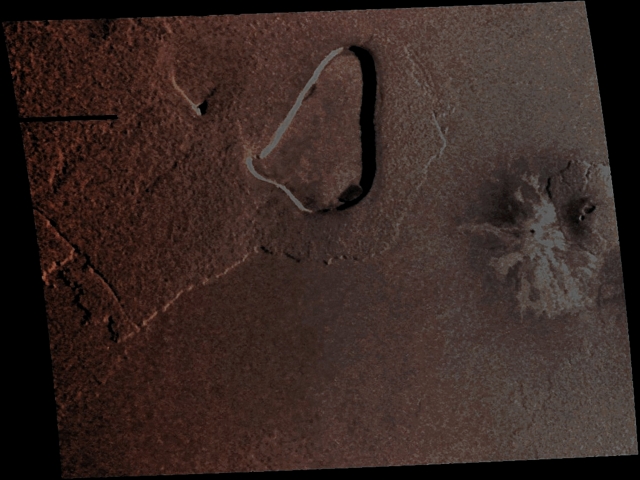
June 8, 2012
Credits: NASA/JPL/Galileo Project - Credits for the additional process. and color.: Dr Paolo C. Fienga/Lunar Explorer Italia/IPF
|
This image was taken by the NASA - Galileo Probe on October, 16, 2001, and it shows a Region located near the Equator of Jupiter's moon, Io. As you can see, the frame shows quite well the contrast in "Volcanism Styles" that is found on this really restless Celestial Body. The central Surface Feature, is a large Patera (such as a Volcanic Depression), almost 100 Km (approx. 60 miles) long. It may have formed when (or right after) some powerful Eruption of Lava emptied a whole Subsurface Magma Chamber on the Surface, and left an empty underground space into which the Crust, after some time, collapsed. However, the evidence of Lava Flows associated with this Patera is rather difficult to find and that is because either the Lava Flows have been buried, or, perhaps, because they never erupted and, once the (relatively quiet, in that case) Eruption ended, they simply drained back (---> retreated) deep into the Crust. On the right side of the image, instead, there is a small Shield Volcano, similar to Volcanoes located in the Hawaiian Islands. You have to consider, anyway, that is very rare for Lavas on Io to be thick enough to pile up into Shields around Vents: in fact, the Lavas on Io usually run out in thin, long flows instead. This Shield abuts some very pale Lava Flows that emerged from a small Vent to the West and these Flows could be made of Sulphur, like the ones located at Io's Emakong Patera. The Vent is also surrounded by dark, diffuse material, which may be the result of Lava that was pushed up and away in an explosive, gas-rich eruption, similar to the one of Mount Saint Helens, in Washington, which occurred in the AD 1980. North is to the top of the image and the illumination is from the right. The image has a resolution of 330 meters (1080 feet) per picture element and it is about 340 (approx. 211 miles) kilometers across. This frame has been colorized in Absolute Natural Colors (such as the colors that a human eye would actually perceive if someone were onboard the NASA - Galileo Probe and then looked outside, towards the Equatorial Regions of the Jovian moon Io), by using an original technique created - and, in time, dramatically improved - by the Lunar Explorer Italia Team. |
News visualized: 815 times

